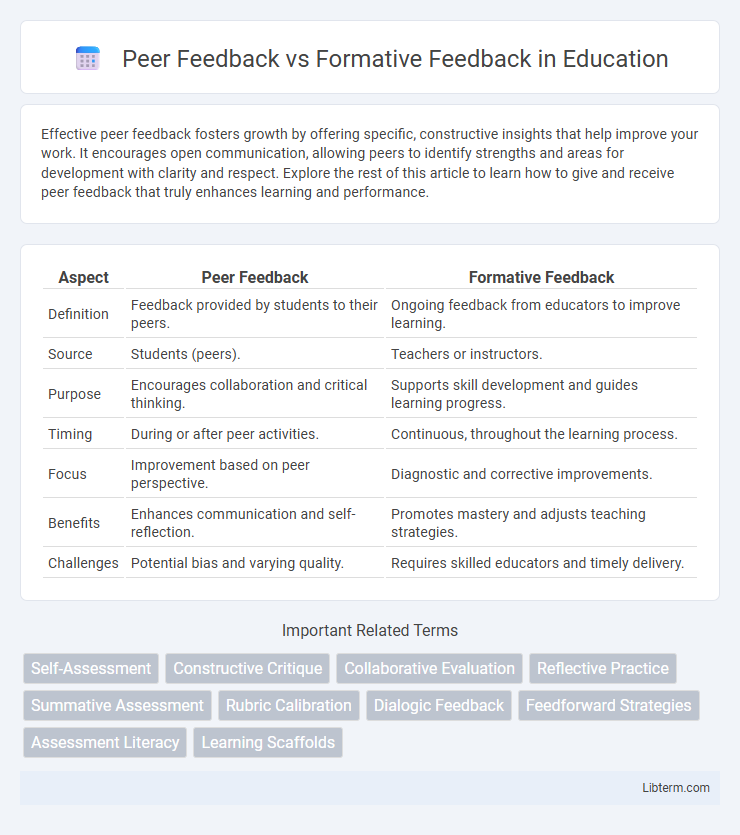Effective peer feedback fosters growth by offering specific, constructive insights that help improve your work. It encourages open communication, allowing peers to identify strengths and areas for development with clarity and respect. Explore the rest of this article to learn how to give and receive peer feedback that truly enhances learning and performance.
Table of Comparison
| Aspect | Peer Feedback | Formative Feedback |
|---|---|---|
| Definition | Feedback provided by students to their peers. | Ongoing feedback from educators to improve learning. |
| Source | Students (peers). | Teachers or instructors. |
| Purpose | Encourages collaboration and critical thinking. | Supports skill development and guides learning progress. |
| Timing | During or after peer activities. | Continuous, throughout the learning process. |
| Focus | Improvement based on peer perspective. | Diagnostic and corrective improvements. |
| Benefits | Enhances communication and self-reflection. | Promotes mastery and adjusts teaching strategies. |
| Challenges | Potential bias and varying quality. | Requires skilled educators and timely delivery. |
Understanding Peer Feedback
Peer feedback involves students assessing each other's work to enhance learning through collaborative insights, promoting critical thinking and self-reflection. It differs from formative feedback, which is typically provided by instructors to guide improvements during the learning process. Understanding peer feedback emphasizes developing communication skills and fostering a supportive learning environment where learners actively participate in knowledge construction.
Defining Formative Feedback
Formative feedback is an ongoing assessment process aimed at providing learners with specific, actionable insights to improve their understanding and performance during the learning journey. Unlike peer feedback, which involves evaluations from fellow students, formative feedback is often delivered by instructors or automated systems to guide skill development and knowledge acquisition. This type of feedback emphasizes continuous improvement by identifying strengths and areas for growth before final evaluations.
Key Differences Between Peer and Formative Feedback
Peer feedback involves students providing evaluations and comments on each other's work, fostering collaborative learning and critical thinking. Formative feedback is given by instructors or assessment tools during the learning process, aiming to guide improvements before final evaluations. While peer feedback emphasizes reciprocal interaction, formative feedback centers on expert guidance to enhance understanding and performance.
Advantages of Peer Feedback
Peer feedback promotes active learning by encouraging learners to critically evaluate their peers' work, which enhances understanding and retention of material. It fosters collaborative skills and communication, facilitating diverse perspectives that improve problem-solving abilities. This method also increases learner engagement and motivation by creating a supportive community where feedback is more frequent and personalized.
Benefits of Formative Feedback
Formative feedback provides timely, specific insights that guide learners in identifying strengths and areas for improvement during the learning process, enhancing skill development. It fosters a growth mindset by encouraging continuous reflection, self-regulation, and adjustment before final assessments. Unlike peer feedback, formative feedback often comes from instructors or experts, ensuring accuracy and alignment with learning objectives.
Common Challenges in Peer Feedback
Common challenges in peer feedback include varying levels of expertise among peers, which can lead to inconsistent or inaccurate evaluations, and personal biases that affect the objectivity of the feedback. Communication barriers and a lack of structured guidelines may result in unclear or unconstructive critiques, diminishing the effectiveness of the process. Ensuring a supportive environment and training participants in constructive feedback techniques can help overcome these obstacles.
Limitations of Formative Feedback
Formative feedback provides ongoing guidance aimed at improving student learning but often suffers from time constraints and inconsistent quality across instructors. It can be limited by subjective interpretation and may not always encourage active student engagement or self-assessment skills. Unlike peer feedback, formative feedback tends to lack diverse perspectives, potentially reducing its effectiveness in fostering critical thinking and collaborative learning.
When to Use Peer Feedback vs Formative Feedback
Peer feedback is most effective during collaborative learning activities and group projects where students actively engage in evaluating each other's work. Formative feedback is best used by instructors throughout the learning process to guide students' understanding and improve performance before final assessments. Employ peer feedback to foster critical thinking and communication skills, while formative feedback helps identify knowledge gaps and tailor instruction accordingly.
Impact on Student Learning Outcomes
Peer feedback enhances student learning outcomes by promoting active engagement and critical thinking, enabling learners to reflect on their work and understand diverse perspectives. Formative feedback provides timely, targeted guidance from educators that helps students identify learning gaps and improve performance before final evaluations. Combining both approaches fosters a collaborative learning environment and supports continuous improvement, leading to higher academic achievement and deeper skill mastery.
Best Practices for Integrating Both Feedback Methods
Incorporate peer feedback by establishing clear criteria and training students to provide constructive, specific comments that promote dialogue and self-reflection. Use formative feedback from instructors to guide learning objectives, highlighting strengths and areas for improvement with timely, actionable insights. Combine both methods through iterative cycles where peer input informs revisions and formative assessments validate progress, fostering a collaborative and growth-oriented learning environment.
Peer Feedback Infographic

 libterm.com
libterm.com